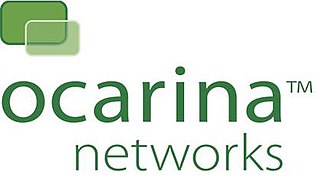In information theory, data compression, source coding, or bit-rate reduction is the process of encoding information using fewer bits than the original representation. Any particular compression is either lossy or lossless. Lossless compression reduces bits by identifying and eliminating statistical redundancy. No information is lost in lossless compression. Lossy compression reduces bits by removing unnecessary or less important information. Typically, a device that performs data compression is referred to as an encoder, and one that performs the reversal of the process (decompression) as a decoder.

Toshiba Corporation is a Japanese multinational electronics company headquartered in Minato, Tokyo, Japan. Its diversified products and services include power, industrial and social infrastructure systems, elevators and escalators, electronic components, semiconductors, hard disk drives (HDD), printers, batteries, lighting, as well as IT solutions such as quantum cryptography which has been in development at Cambridge Research Laboratory, Toshiba Europe, located in the United Kingdom, now being commercialised. It was one of the biggest manufacturers of personal computers, consumer electronics, home appliances, and medical equipment. As a semiconductor company and the inventor of flash memory, Toshiba had been one of the top 10 in the chip industry until its flash memory unit was spun off as Toshiba Memory, later Kioxia, in the late 2010s.

Fractal compression is a lossy compression method for digital images, based on fractals. The method is best suited for textures and natural images, relying on the fact that parts of an image often resemble other parts of the same image. Fractal algorithms convert these parts into mathematical data called "fractal codes" which are used to recreate the encoded image.
Lempel–Ziv–Welch (LZW) is a universal lossless data compression algorithm created by Abraham Lempel, Jacob Ziv, and Terry Welch. It was published by Welch in 1984 as an improved implementation of the LZ78 algorithm published by Lempel and Ziv in 1978. The algorithm is simple to implement and has the potential for very high throughput in hardware implementations. It is the algorithm of the Unix file compression utility compress and is used in the GIF image format.
Quantum Coorperation is a data storage, management, and protection company that provides technology to store, manage, archive, and protect video and unstructured data throughout the data life cycle. Their products are used by enterprises, media and entertainment companies, government agencies, big data companies, and life science organizations. Quantum is headquartered in San Jose, California and has offices around the world, supporting customers globally in addition to working with a network of distributors, VARs, DMRs, OEMs and other suppliers.

Stac Electronics, originally incorporated as State of the Art Consulting and later shortened to Stac, Inc., was a technology company founded in 1983. It is known primarily for its Lempel–Ziv–Stac lossless compression algorithm and Stacker disk compression utility for compressing data for storage.
Permabit Technology Corporation was a private supplier of Data Reduction solutions to the Computer Data Storage industry.
Green computing, green IT, or ICT sustainability, is the study and practice of environmentally sustainable computing or IT.
StorNext File System (SNFS), colloquially referred to as StorNext is a shared disk file system made by Quantum Corporation. StorNext enables multiple Windows, Linux and Apple workstations to access shared block storage over a Fibre Channel network. With the StorNext file system installed, these computers can read and write to the same storage volume at the same time enabling what is known as a "file-locking SAN." StorNext is used in environments where large files must be shared, and accessed simultaneously by users without network delays, or where a file must be available for access by multiple readers starting at different times. Common use cases include multiple video editor environments in feature film, television and general video post production.
In computing, data deduplication is a technique for eliminating duplicate copies of repeating data. Successful implementation of the technique can improve storage utilization, which may in turn lower capital expenditure by reducing the overall amount of storage media required to meet storage capacity needs. It can also be applied to network data transfers to reduce the number of bytes that must be sent.

Ocarina Networks was a technology company selling a hardware/software solution designed to reduce data footprints with file-aware storage optimization. A subsidiary of Dell, their flagship product, the Ocarina Appliance/Reader, released in April 2008, uses patented data compression techniques incorporating such methods as record linkage and context-based lossless data compression. The product includes the hardware-appliance-based compressor, the Ocarina Optimizer and a real-time decompressor, the software-based Ocarina Reader.
ZPAQ is an open source command line archiver for Windows and Linux. It uses a journaling or append-only format which can be rolled back to an earlier state to retrieve older versions of files and directories. It supports fast incremental update by adding only files whose last-modified date has changed since the previous update. It compresses using deduplication and several algorithms depending on the data type and the selected compression level. To preserve forward and backward compatibility between versions as the compression algorithm is improved, it stores the decompression algorithm in the archive. The ZPAQ source code includes a public domain API, libzpaq, which provides compression and decompression services to C++ applications. The format is believed to be unencumbered by patents.
NetVault is a set of data protection software developed and supported by Quest Software. NetVault Backup is a backup and recovery software product. It can be used to protect data and software applications in physical and virtual environments from one central management interface. It supports many servers, application platforms, and protocols such as UNIX, Linux, Microsoft Windows, VMware, Microsoft Hyper-V, Oracle, Sybase, Microsoft SQL Server, NDMP, Oracle ACSLS, IBM DAS/ACI, Microsoft Exchange Server, DB2, and Teradata.
Infineta Systems was a company that made WAN optimization products for high performance, latency-sensitive network applications. The company advertised that it allowed application data rate to exceed the nominal data rate of the link. Infineta Systems ceased operations by February 2013, a liquidator was appointed, and its products will no longer be manufactured, sold or distributed.

Nimble Storage, founded in 2008, is a subsidiary of Hewlett Packard Enterprise. It specializes in producing hardware and software products for data storage, particularly data storage arrays that utilize the iSCSI and Fibre Channel protocols, and includes data backup and data protection features.
Disk-based backup refers to technology that allows one to back up large amounts of data to a disk storage unit. It is often supplemented by tape drives for data archival or replication to another facility for disaster recovery. Additionally, backup-to-disk has several advantages over traditional tape backup for both technical and business reasons. With continued improvements in storage devices to provide faster access and higher storage capacity, a prime consideration for backup and restore operations, backup-to-disk will become more prominent in organizations.
StorTrends is a brand name of disk-based, hybrid array, and solid state storage products for computer data storage in data centers, sold by AmZetta Technologies. Formally a division of American Megatrends, StorTrends appliances utilize the iTX architecture, which includes features such as deduplication and compression, SSD caching and SSD tiering, automated tiered storage, replication, data archiving, snapshots, WAN optimization, and a VMware vSphere plug-in.
Virtual memory compression is a memory management technique that utilizes data compression to reduce the size or number of paging requests to and from the auxiliary storage. In a virtual memory compression system, pages to be paged out of virtual memory are compressed and stored in physical memory, which is usually random-access memory (RAM), or sent as compressed to auxiliary storage such as a hard disk drive (HDD) or solid-state drive (SSD). In both cases the virtual memory range, whose contents has been compressed, is marked inaccessible so that attempts to access compressed pages can trigger page faults and reversal of the process. The footprint of the data being paged is reduced by the compression process; in the first instance, the freed RAM is returned to the available physical memory pool, while the compressed portion is kept in RAM. In the second instance, the compressed data is sent to auxiliary storage but the resulting I/O operation is smaller and therefore takes less time.
Dell EMC Data Domain was Dell EMC’s data deduplication storage system. Development began with the founding of Data Domain, and continued since that company’s acquisition by EMC Corporation.
William "Chuck" Easttom II is an American computer scientist specializing in cyber security, cryptography, quantum computing, and systems engineering.





